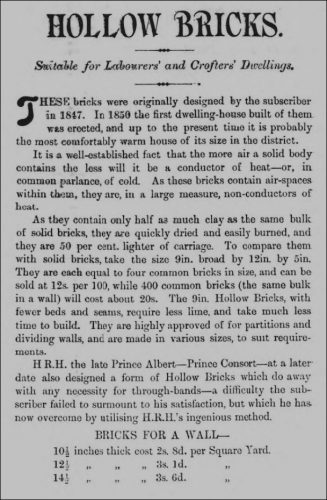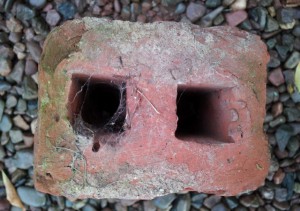04/06/1851 – North British Agriculturist – Hollow bricks. In the model cottages erected by Prince Albert, and to which considerable attention has been of late directed, the material used in their erection is hollow bricks, the roofs being arched with the same. It is impossible to estimate the advantages which may probably result from this new method of forming bricks. The discovery has been patented by Mr Roberts, and this may for a time limit its general adoption. For buildings requiring strength such as barns, granaries, &c., there is every probability that they will be found unsuitable, except at a great expense for material to fit them to stand the pressure and motion of machinery. But for ordinary buildings, we believe they will be found highly suitable, and more particularly for labourers cottages, almost always damp and uncomfortable, particularly from the materials employed in their construction, Where cottages are unplastered, as many in Scotland are, these hollow bricks will form a smoother surface, both internally and externally. It is stated that they can be sold from 20 to 30 per cent. cheaper than ordinary brick, requiring also less mortar. They are particularly adapted for the transmission of artificial heat and may used for garden walls, water pipes, bell wires, ventilation, &c. A farther recommendation is that they are well suited for partitions, roof and floor arches, as they are fireproof, deaden sound, and when dovetailed make a more secure centre wall than the ordinary brick. They can be made out of such clay as is suitable for making drain tiles, and by the same machines, and at about the same expense calculated by the quantity of material used. For the ordinary buildings upon a farm, they appear to be specially adapted, such as stables, feeding-byres, &c., dryness and warmth with proper ventilation being found of the greatest importance for the health and the general economy of the whole animal kingdom. We trust some of our more spirited proprietors will set the example of using hollow bricks in the construction of such buildings, and more particularly the cottages of the labouring classes
19/07/1902 – Peterhead Sentinel – The Highland and Agricultural Society’s Show … One of the most interesting stands at the show was that of William Forbes, Newark Brickwork, Ellon, who had a capital exhibition of the various varieties of brickwork, for the manufacture of which he has such a reputation. His exhibits included specimens of his patent drain paving for cattle stalls; half collared impervious pointed pipes for conveying water purity, or for sewage; improved segment pipes for building culverts, mill races, and for lining walls; hollow bricks now so largely used, owing to their utility combined with small cost, for building dividing walls in dwellinghouses, and the outer walls of cottars and crofters houses, barns, byres, sheds, etc; Albert bricks, the invention of the late Prince Albert, for building cottages; as well window ribats, corners, etc., for Albert bricks. Mr Forbes’s pavement for bullock stalls is said to be found exceptionally satisfactory for the purpose. Forbes himself, now in his seventy-sixth year, was in attendance the stall, and by a series of leaflets, as well as his interesting explanations of his wares, contrived to make Stall 154, a source of no small attraction …
Below – 26/07/1902 – Peterhead Sentinel – William Forbes advert and reference to the hollow brick patent of H.R.H Prince Albert.



